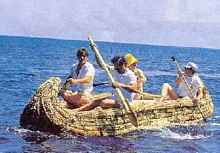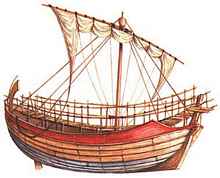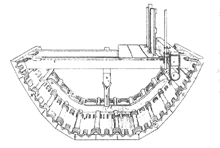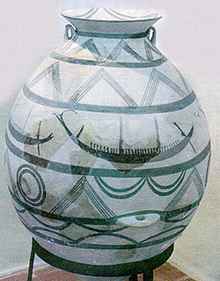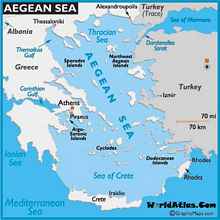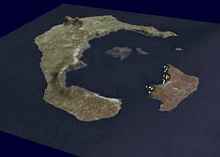
 Custom Search
|
|
| sails |
| plans |
| epoxy |
| rope/line |
| hardware |
| canoe/Kayak |
| sailmaking |
| materials |
| models |
| media |
| tools |
| gear |
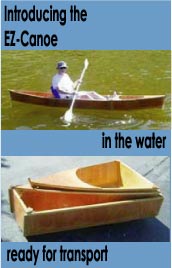 |
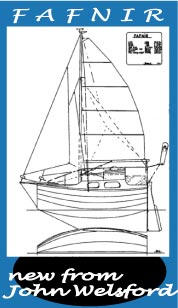 |
| join |
| home |
| indexes |
| classifieds |
| calendar |
| archives |
| about |
| links |
| Join Duckworks Get free newsletter Comment on articles CLICK HERE |
|
|
| Out There |
by Paul Austin - Dallas, Texas - USA The First Boats |
 |
Think you could paddle 80 miles across an ocean? In a reed boat with no canopy? The men of a Greek island called Melos did, and they took some rocks with them to a place in southern Greece called Argolid. This little venture happened more than 4950 years BE (Before Elvis: 3000BC + 1950) (Gardiner, Morrison, Age of the Galley, p. 10).
The boat as you can see was a double-ender, made of reeds called papyrelli, raised fore and aft with stations for 6 rowers. Open water, open boat, cold, wet, no land in sight for at least a day or two. So why do that? In the island of the Aegean around Greece and modern Turkey the islands don't have any real farming. The men had to row somewhere else to feed their families. In fact, the Trojan War was about the Greeks controlling the shipping and trade in the eastern Mediterranean. The earliest record of any sailboat is from the Egytians, who used square sails on their long narrow vessels to transport soldiers in a hurry (Ibid, p. 11). A soldier named Uni under Pepi I ( these guys go in for short names) wrote that the people near the present day Haifa were rebelling. Five times he had to transport soldiers to crush 'these foreigners in Antelope-Nose.' Now there's a name for you. Evidently in ancient times a mountain range came down to the Mediterranean there, resembling an antelope's nose. I like Uni. He calls the people of Antelope's Nose, backsliders - evidently Baptists. They went down the mountain range to get baptized, but they kept sliding into the sea too soon, thus, backsliders. Uni brought back some of these backsliders to Egypt to be slaves. But no venture to sea in ancient times could come back empty-handed. Uni brought back loads of timber, ebony, ivory, resins and spices. The cedar and cypress he brought back probably came from the same forest north of Beirut where the Sidonians cut timber for Solomon's temple in 1 Kings 5 of the Old Testament, around 850BC. Having loaded the hold of his ships, Uni came back to Egypt from the port of Byblos. From then on, any Egyptian cargo ship was called 'Byblos-ship.' (Ibid. p. 11)
In a temple to Sahure (who?) at Abusir, there is an illustration of the Egyptian Byblos ships. They are long, narrow, with a dipping sheer, vertical stem and stern. What's suprising about this illustration is a truss roped to the inside of the stem and stern in a massively tight arch to keep the boat's rocker in shape. Some scholars think the dipping sheer might be exaggerated. However, it may not be. The sheer might be that way to eliminate stealers as the planking would come from garboard around the bilge to the sheer. A huge rope went around the inside of the sheer, all the way around, to keep it in place. This was probably mandatory with no deck beams to hold the ship in shape.
These ships were planked up with rope and resins. (At this point, the concept of lashings by the Egyptians is still conjecture, even though nearly all scholars agree.) They used 3 oars per side to steer. We now know from building replicas the oars didn't do much of the steering. Men maneuvered the sails for most of the steering. They also cut the sails different shapes for different voyages. The sails balanced the boat. Why didn't the Egyptians use trunnels? Because they needed to take these ships apart to transport them from the Red Sea to the Mediterranean and back. They were the first folding boats on a grand scale. While the Egyptians were dealing with backsliders, the Phoenicians were sailing from island to island in the Aegean for trade and conquest. Funny how the trade and conquest go together. The name Phoenician is from the Greek words for 'purple cloak' (Robert Ballard, Mystery of the Ancient Seafarers, p. 14.). The Phoenicians were well known for dying their cloaks purple. These cloaks were admired all over the Mediterranean.
There is a model of a ship found on the island of Naxos, which is interesting. It has the widest beam well astern of the midframe. When the Egyptians used the sails to steer and balance the boat, they were identifying with the wind; the sea was simply in the way. However, the Naxos boat is shaped for water, not wind. The Phoenicians were the master shipbuilders of the ancient world before 1500BC. Not only were they masters at cutting trees into planks, they invented the mortise to slip into the tenon of a plank. This meant the plank had to be thick and heavy. They put frames inside the planking before any one else did (Ibid, p. 28.). They were the first to circumnavigate the continent of Africa. To keep track of their far-flung business interests they invented the alphabet which evolved into the one I'm using now.
But the world's first real maritime power were the Minoans of Crete. The island of Crete is the door to the Aegean. The Minoans dominated the Aegean and its' islands for trade and military control. Their ships were not long like the Egyptian ships. They were propelled by oars with a center mast and sail. These features seem to indicate fast maneuverable ships rather than the long heavy craft of the Egyptians. The age of the Minoans we call the Late Bronze Age. They used bronzed tools to shape the planks smoother and closer than had been done before. Their two handed saw was 4-5 feet long (minoanatlantis.com). With this saw and short axes, the Minoans cut down cypress trees, carted them to the shore with oxen, and then stripped the tree of its bark. Then a shipwright marked on the naked wood how he wanted the tree cut. Researchers believe the Minoans knew enough to steam bend planks for a stem and stern that rose 20 feet high. The planks went together mortise and tenon, with the tenons sometimes at angles to the surface of the plank to make a turn up from the keel. Then the joints between planks were filled with resins. At this point holes were drilled at right angles to the plank with tenons inserted, completely through the plank and tenon. The hole was filled with resin, then a trunnel was hammered into the hole. By this time, the planks were pretty tight and very strong. Little caulk or resin was needed inside the hull. The planks went on each side at the same time, till they were half way to the sheer. At this time the men went inside the hull to frame it up from keel to above the waterline. The rowing benches were put in and the deck, which was partial. The final job was to cover the ship with woven linen, painted white with scenes of birds and dolphins. Sort of a 150 foot canvas job. The canvas salesman could probably retire to Miami Beach. The mast was solid oak, 30-40 feet tall in a powerful mast step. The ropes securing it were hemp. The boom was held by a thick look of rope, loosely fitted to allow the boom to move according to the wind. The sail was linen dipped in oils with a mesh net on one side to keep it from ripping. With the superiority of the Minoans at sea, had they lived long enough the history of Greece and the ancient world would have been different. Crete guarded the Aegean. The Greeks could not have sailed out of the Aegean without dealing with the Minoans, who were the best sailors and soldiers of the Bronze Age. A great sea war would have ensued, rather than a Trojan War. So what happened? It's a mystery. After 1500BC Mycenaeans from the Greek mainland simply took over Crete, apparently unopposed. Scientists know that around 1600BC the volcano on the neighboring island of Thera erupted, collapsing the center of the island, into the sea. Only a wide circular rim of land remained. Small eruptions from the sea floor has resulted in a small island in the middle of the circle of land. This is now called Santorini.
What we now believe is that this volcanic eruption might have caused a tidal wave, swamping the Minoans and their ships. The usual date for the tidal wave is around 1600BC, remarkably close to the time of the Trojan War. Paul Bibliography: Pulak, Cemal and Bass, George F. "Bronze Age Shipwreck Excavation at Uluburun". Institute of Nautical Archaeology. ***** This is Paul's Blog: https://crossingthoughts-paul.blogspot.com.au Paul is also publishing his books on Amazon. ***** |
